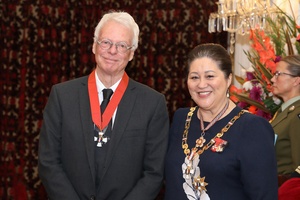Finding a public voice
Opinion: Pip Cheshire believes architects should be at the vanguard of those giving voice to improve our environment, and that the Institute should be their megaphone.

Have you sorted out your response to the current government’s strategy for the environment yet? Has Minister Penk’s reduction in keeping a Kiwi house warm and dry shaken loose projects stalled under budget pressure, and are you bringing out a new range of backyard tenements, free from the purview of zealous bureaucratic eyes?
If you think the trio running the country seems to be laying waste the country’s fledgling attempts to address the requirements of the Paris Accord with indecent haste, you might give a thought to the philosophical ram raid on our gentle country staged by the fourth Labour government some 40 years ago. I understand this is pretty much ancient history for you TikTokkers out there but, if you can spare a couple of hours to listen to The Spinoff’s ‘Juggernaut’ podcast, you will hear of a committed gang of ideologues profoundly changing almost every aspect of life in our little motu.
The podcast describes the reach of new legislation introduced to float our dollar, reduce taxes, dismantle import licensing, remove protections and tariffs, and sell off the Bank of New Zealand and the railways, and that was just for starters. The relentless and speedy assault on the foundations of our egalitarian managed economy allowed little time for opposition. That the changes were promulgated by the Labour Party, the traditional home of the urban workers most disadvantaged by the changes, further confounded opposition.
If two or three hours of Aotearoa history sounds just way too slow, the long and short of it is that a blitzkrieg was waged by then newly elected finance minister Roger Douglas and a couple of fellow travellers on every aspect of the country’s financial and fiscal structure. Perhaps you think, as Henry Ford did, that “history is more or less bunk…”. However, Douglas was one of the founders of the Association of Consumers and Taxpayers, better known by its acronym, ACT: one of the three legs of the gang currently occupying the Beehive, and eviscerating our efforts to mitigate the effects of climate change.
All this seems irrelevant in the face of global issues that, frankly, make the sale of a railroad system or a banking institution trivial. The wild peregrinations of our elected representatives in Wellington make me weep for those inheriting the planetary mess we have brought about, and continue to add to. Our nation’s output of noxious gases from car and cow alike might be puny on a world stage filled with coal-fired power stations but we might yet present an exemplar society living in some sort of balance with our, admittedly, much modified nature, were we to have a mind to.
Many believe this is the stuff of government alone, and that, after winning the votes of the floating five per cent and sweeping past the balloons and streamers of election night, a coterie of policy wonks in the hive will sort things out. It doesn’t really work that way. The triennial November queues outside the local school hall invariably lead to looping once more around the Möbius strip of centrally directed hope and despair, as the winners seek to consolidate and hold power and the other lot seeks to criticise without straying too far from the dreams of the five per cent. For all that, the elected pollies in Te Whanganui-a-Tara are still, in some small ways, accountable, be it through submissions to the select committees, petitions, street marches or, in the last resort, the taking up of pitchforks and Molotov cocktails. We came close to the latter in the 1951 waterfront strike and the ’81 footy tour but it is in the arcane processes of the select committee that we, the mob, might best affect proposed legislation.
The current onslaught of legislation has included a proposal to allow selected projects to bypass the processes of consideration and review embedded in the Resource Management Act and head off to a triumvirate of ministers for quick-fire planning decisions. For many, the avoidance of many weeks, months or even years of hearings before getting the ’dozers into action would surely be a good thing. For others, the bypassing of submission, debate and appeal heralds the way to short-term goals gained at the expense of the environment.
The proposed legislation pits the possible development of infrastructure to keep us charging down the highway of increasing gross domestic product against the less-measurable value of protection of the environment. We might support, say, a stable road over or round the Brynderwyns but what of deep-sea mining in the South Taranaki Bight? In the latter, the complex effects on marine life of hoovering up the ocean bed to extract heavy metals deserves greater exposure, public debate and consideration than that offered by three ministers of the crown.

As we know, many took a dim view of the proposal and took to the streets in early June this year. Many individuals and organisations also made submissions against the proposal to the select committee considering the bill. I am sorry to say that, while individual architect members protested, the Institute of Architects was not amongst the nearly 27,000 submitters. It may be that the Institute was distracted by its recent purge of head office or, perhaps, the burgeoning awards programme left no resources for cobbling something together. I rather suspect, though, that it remains uncertain as to how, or if, the Institute should transition from an hermetic ‘learned society’, promoting and protecting the immediate interests of its members, to a more audible and visible voice for the built environment.
Where the Institute has taken a public position on specific architectural issues in the public domain, it has found itself in tempestuous waters in the past. It is understandably reticent about antagonising members responsible for projects that have become causes célèbres and subjects of the Institute’s opprobrium. Speaking out against proposed legislative change is, however, free of the potential for such conflict and our collective silence in this regard must only reinforce the public view that our primary concern is the self-congratulatory awards programmes and, using a crude colloquialism, ‘putting lipstick’ on the pigs that litter our cities’ main streets.
This is an unfair and inaccurate perception. The Institute’s members working in ad hoc groups focused around specific local issues have made huge contributions to their local environments and the myriad controls shaping construction in this country. The enormous effort by Auckland members in the review and subsequent shaping of the Auckland Unitary Plan is one such contribution, its success in providing a robust blueprint for the city’s growth perhaps underlined by its witless supplanting, under the aegis of meddling, headline-seeking pollies in the south.
If nothing else, architects’ visible commentary on proposed changes to the legal, commercial and planning environment in which we operate is good marketing for a trade many of the public, our customer base, find opaque. I am certain many of us are, in addition to providing for kith and kin, motivated by the chance to improve the lot of those around us. Certainly, this is more necessary than it has ever been; whatever your scale of thinking, be it local planning controls, thermal performance of buildings or the stability of the West Antarctic ice shelf, we architects should be at the vanguard of those giving voice. This would be all the louder were the Institute to be the megaphone.










